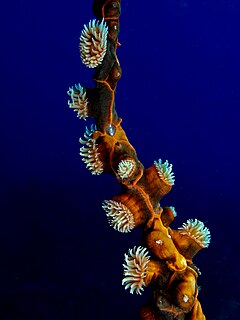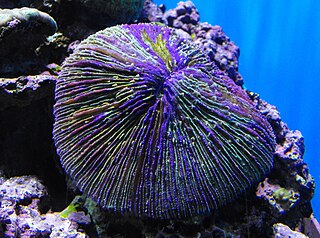
Bathyteuthis is the singular genus of squid in the family Bathyteuthidae, encompassing three species. None has a mantle length greater than 80 mm.

Tube-dwelling anemones or ceriantharians look very similar to sea anemones but belong to an entirely different subclass of anthozoans. They are solitary, living buried in soft sediments. Tube anemones live inside and can withdraw into tubes, which are composed of a fibrous material made from secreted mucus and threads of nematocyst-like organelles known as ptychocysts. Within the tubes of these ceriantharians, more than one polyp is present, which is an exceptional trait because species that create tube systems usually contain only one polyp per tube. Ceriantharians were formerly classified in the taxon Ceriantipatharia along with the black corals but have since been moved to their own subclass, Ceriantharia.

The dahlia anemone is a sea anemone found in the north Atlantic Ocean, the North Sea and the Baltic Sea. Its colour is variable, from deep red to brown or purplish, with green spots and darker tentacles. Dahlia anemones live attached to rock on the seabed from the lower tidal limit down to a depth of 100 m and also attached to other organisms. Their diet comprises small fish and crustaceans, which they immobilize by firing groups of stinging cells (cnidae) into them. Dahlia anemones are closely related to mottled anemones, and both species are usually referred to as northern red anemones.

Turbonillinae is a subfamily of mostly minute parasitic sea snails, marine gastropod molluscs in the family Pyramidellidae, the pyrams and their allies.

The Trochidae, common name top-snails or top-shells, are a taxonomic family of very small to large sea snails, marine gastropod molluscs in the clade Vetigastropoda.

Limaria, the file shells or file clams, is a genus of marine bivalve molluscs in the family Limidae.

Corallimorpharia is an order of marine cnidarians closely related to stony or reef building corals (Scleractinia). They occur in both temperate and tropical climates, although they are mostly tropical. Temperate forms tend to be very robust, with wide and long columns, whereas tropical forms tend to have very short columns with a wide oral disc and very short tentacles. The tentacles are usually arranged in rows radiating from the mouth. Many species occur together in large groups, although there are recorded instances of individuals. In many respects, they resemble the stony corals, except for the absence of a stony skeleton. Morphological and molecular evidence suggests that they are very closely related to stony corals.

Bolocera tuediae, commonly known as the deeplet sea anemone, is a sea anemone found in the sublittoral zone of the North Sea. It was first discovered near Bewick, England by Johnston in 1832. It is distinguished by its large, hexamerous size and shedding of tentacles. The nematocysts of the anemone can have dangerous effects, including the rupturing of human blood cells. The deeplet sea anemone was observed to have a symbiotic relationship with shrimp, as they cluster around its base in both temperate and Northwest Atlantic waters.

Liponema brevicorne, commonly known as pom-pom anemone or tentacle shedding anemone, is a species of sea anemone in the family Actiniidae. It is a deep water species and has been relatively little observed. It often remains unattached to a substrate and can roll across the ocean floor propelled by water currents.

Amphianthus is a genus of sea anemones. It is the only genus in the monotypic family Amphianthidae.

Sagartia ichthystoma is a species of sea anemone in the family Sagartiidae, also known as the fish-mouth anemone. The species name refers to the short pointed tentacles round the edge of the disc which resemble the sharp teeth of certain fish.

Metridium senile, or frilled anemone, is a species of sea anemone in the family Metridiidae. As a member of the genus Metridium, it is a type of plumose anemone and is found in the seas off north-western Europe and both the east and west coasts of North America.

Favia is a genus of reef-building stony corals in the family Mussidae. Members of the genus are massive or thickly encrusting colonial corals, either dome-shaped or flat, and a few are foliaceous. There is a great diversity of form even among individuals of the same species. The corallites project slightly above the surface of the coral and each has its own wall. In most species, the corallites are plocoid and in some, monocentric. The septa and costae linked to the corallite wall are well developed and covered by fine teeth. The polyps only extend and feed during the night. Each one has a small number of tapering tentacles which often have a darker coloured tip; these are called stinger tentacles, or sweeper tentacles. They use these to sweep the water to see if any other coral is in its area; if so, then they begin to sting the other coral. This is commonly known as coral war. Each coral is trying to make sure it has enough room around it so it can continue to grow and have more surface area for its offspring. The columella is parietal and spongy, and there are vesicles on both the endotheca and exotheca. Members of this genus are widespread in both the Atlantic Ocean and the Indo-Pacific.

Haloclavidae is a family of sea anemones. Members of the family are found worldwide and many live largely buried in soft substrates with only their oral disc and tentacles protruding.

Peachia is a genus of sea anemone in the family Haloclavidae. Members of this genus typically burrow into soft substrates. The only part of the animal that is normally visible is the oral disc and tentacles which lie flat on the sand in a star shape. The type species is Peachia cylindrica.
Peachia cylindrica is a large species of sea anemone in the family Haloclavidae. It is normally found burrowed into soft substrates, the only visible part of the animal being the oral disc and tentacles which usually lie flat on the sand. It is the type species of the genus Peachia.

Olindias is a genus of hydrozoans in the family Olindiidae.

Fungia is a genus of corals in the family Fungiidae. It is monotypic with the single species Fungia fungites, which is found growing on reefs in the Indo-Pacific.
Firoloida is a monotypic genus of pelagic marine gastropod mollusc in the family Pterotracheidae, with the only species in the genus being Firoloida desmarestia. This shell-less mollusc is found in tropical and sub-tropical waters in the epipelagic zone of the world's oceans.

Gonactinia is a monotypic genus of sea anemones, and G. prolifera is the only species in the genus. It is sometimes called the storey anemone and is found on either side of the northern Atlantic Ocean.

















